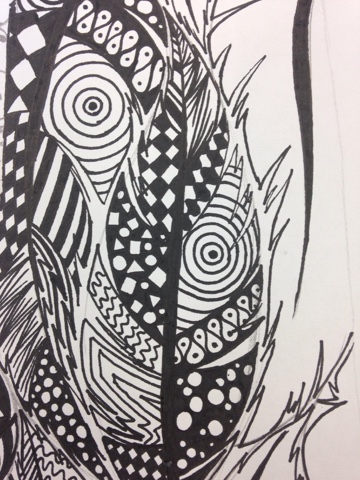Jess then began to explain the process of Lino printing to the group as we would produce prints of our designs using this process. Lino printing is a type of relief printing in which you carve your design into a block of Lino then apply ink using a brayer (rubber paint roller) and put it through a printing press with a sheet of paper. After processing the explanation we began sketching our designs onto blocks of Lino. As our current project is revolved around hands I adapted my design so that it appeared to be a henna design on the back of a hand. Unfortunately you can only just see the sketch of my design on the Lino but here is a picture:
Now we began to carve away using the Lino cutters. At first I kept being too heavy handed resulting in me cutting out large pieces of Lino however eventually I began to get the hang of it using different sized Lino cutters to carve out the intricate details of the feathers.
We then proceeded to rolling on the ink and printing our designs onto paper. It took a while to apply the right amount of paint that was needed, as you can see the first try was quite pale.
I then began experimenting with colour and paper to achieve different affects. I preferred using warm colours on the brown paper as I believe it helped me achieve the tribal affect I had originally wanted.
Jess then explained how to 'La poupée' which is a French term for using different coloured inks when print-making. To continue with my tribal theme I used red and black for this technique and I thought the results were really successful!
The finish the day we wer taught another technique, China Collé, which is another French term meaning we would glue coloured tissue to the paper before printing onto it. I used some purple tissue paper in the shape of a hand and then used red and yellow to print onto the paper. It didn't work as well as I had hoped because I put Abit too much ink on to the Lino so the design is smudged and the tissue paper is hidden. I hope I will find the time to practise China Collé as I'd love to produce some work using this technique.









No comments:
Post a Comment